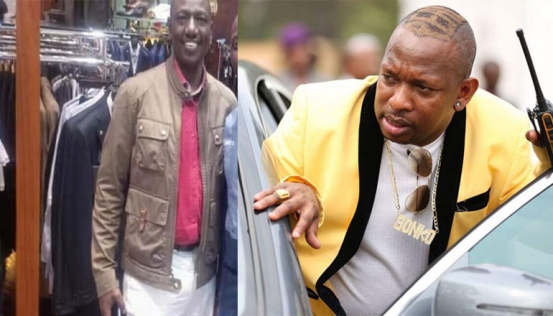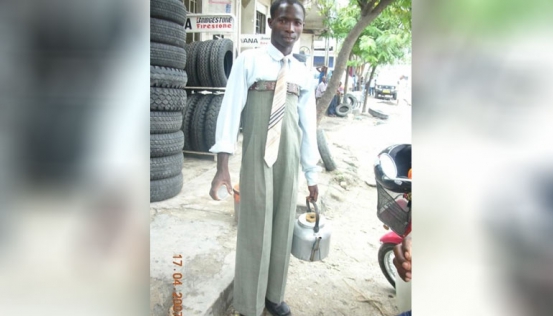
A brown Rexine jacket recently took the internet by storm after it was labelled a favourite among the Kalenjin. With a light touch, Kenyans on Twitter, a majority of them Kalenjins, made fun of the ‘cheget’, which appears to be a hit in their highlands.
While Kenyans can be cunning, faking their background with accents, grooming and choice residences West of Uhuru Highway; their dress codes almost always betrays their ethnic backgrounds.
Indeed, every Kenyan community has its ‘tribal’ dress code: Kikuyu men love black leather jackets, shirts unbuttoned down hairy chests, Savco jeans and cowboy boots when they go for mugithi night outs. Kikuyu also love brimmed hats, caps, marvins and anything that covers their Central Kenya conks. But of particular interest is the godfather hat that is a favourite of their musicians and politicians.
Kambas love yellow and all colours of the rainbow. And why do Luhya men wear suits with sneakers? There must be something about communities and colour coding in the fashion department. How else do you explain why some women from certain communities have a weakness for kamisi than others?
Or why the Luo man loves his high-waist trousers despite it going out of fashion with Congolese Kwasa Kwasa music? Or why Merus love pull neck sweaters?
The Nairobian went searching for fashion sense answers and the results were as amazing as a ‘Kao’ in a technicolour dream coat. Here goes:
Kales
These brothers and sisters from the Rift Valley profess an undying love for the uniform. The recent hullabaloo over their penchant for the brown ‘cheget’ with pictures showing a line-up of brown jackets in a banking hall is a case in point.
It all started when Cherangany MP Wesley Korir appeared in his trademark brown ‘cheget’ on TV, which got observers arguing that the Kalenjin sense of fashion is inspired by politicians. Most also love wearing suits accompanied with Safari boots which is a fashion blooper.
The famous ‘cheget’ is a carryall attire that those in the know claim has enough room to hide hundreds of thousands of shillings from cattle sales and a simi for protection to keep watu wenye mikono mirefu at bay.
What’s more, the favourite Rexin material means the cheget is an all-weather wear - all you need to do is wipe off the dirt from the shamba or boda boda dust and voila! You are ready for a bank appointment or office.
Kalenjin women don’t really have a defined dress code, but they have a weakness for flowing dresses that don’t reveal much, and kitambaa ya kichwa. They also love skirt jeans which looks really funny when worn with high heels.
Cultural translator Gwada Ogot, explains that community dress codes are a colonial hangover. “Most Kalenjins associate Safari boots with power because that’s what colonialists wore when they were at the highlands,” he explains. “The jacket is a product of the environment. They are not popular elsewhere because it’s not as cold as the areas where Kalenjins settled.”
Okuyus

The Kikuyu men are not complete without Savco 1.5 Freezer jeans, preferably brown, Chicago Bulls T-shirts, North Star sneakers, cowboy boots, godfather hats and an oversize, faded black ‘Kenyatta leather jacket.’ Then there is the must-have checked shirt that he tucks in and a belt with a silver buckle that stands out.
As for women, you will know they’re from Central Kenya if you spot those tying belts above their checked, pleated dresses. The tiny, shiny belt will probably disappear in their body mass! Gwada explains that the Kikuyu’s love for this sort of gear “is influenced by the coloniser who loved wearing boots and leather jackets in the farm. It’s partly influenced by the need to appear powerful and the weather.”
But again, the black leather jacket was greatly influenced by Mzee Jomo Kenyatta, who loved wearing one, hence their association with power.
The cowboy boots and godfather hats are their link to love for country music, whose artistes like Don Williams and Kenny Rogers wore them for that ‘cowboy’ country look, which was later borrowed by Kikuyu musicians.
Isn’t the one-man guitar a variation of the American country musician and his guitar anyway?
Luo-peans

The Omera from the village will wear an orange muscle shirt (and not necessarily to betray his vote in 2017) and tuck it in formal high-waist trousers. His feet will be in white sharpshooters as he throws around ‘very big’ English words to intimidate his semi-illiterate relatives.
Born Tao’s on the other hand love their white linen suits, pilot shirts and imported designer suits. Their Canali shoes don’t come cheap.
Luo women are not different from their men. Even if they don’t spend so much on their wardrobes, their cheap mitumba designer labels from Toi Market are well-ironed and a little body splash can make you think they shop in Milan, Italy. They love spandex and six-inch high heels.
Gwada is in his element discussing a community he understands from close quarters: “Luo’s have to dress like they have money because they believe clean people cannot look cheap. It’s some sort of overcompensation, seeing that they don’t really circumcise since they have a lot of water to shower. Wearing cheap clothes may be confused for dirt, and why would anyone wear dirty clothes on top of a clean body?” Gwada poses.
The Baengele
Typical Luhyas also love the uniform, or ill-fitting, dark-blue suits and a yellow shirt with plastic sports shoes over the weekends. He will carry a newspaper and stuff wrapped in a green paper bag as he ambles home to his two wives and 16 children squeezed in a 12 by 10 house in Kawangware. That is when he’s not riding a bicycle while listening to a transistor radio glossing over salam programmes.
Luhya women love brown kitenges and dark-blue skirt suits. But one thing that stands out is the petticoat peeping underneath their outfits. That lace on the petticoat comes in various colours, from yellow to green. And their men actually love it!
Gwada explains that communities in Western Kenya were infiltrated by religious organisations that flaunted uniformity. “Regimentation meant speaking in the same language. In the former Western Province, the colonisers were religious and that influence still manifests itself in many ways. The Luhya became domesticated like the mzungu women they saw wearing a kamisi while their men wear uniforms, like they saw their religious leaders doing. That explains why even most religious organisations like Legio Maria still wear uniforms.”
Indeed, the Salvation Army (Jeshi La Wokovu) and their crisp, white uniforms have adherents most prominent among the Luhya.
The Kaos
The bright yellows and luminous greens could have been created with Kambas in mind. Kambas buy their clothes twice a year: during Easter and Christmas. These outfits will be interchanged for all occasions, from burials to weddings and even official functions.
Every Kamba woman, including children, has a handbag which is carried to church, chama meeting and even a short visit to the shops.
Gwada says the colour clashing famous among Wakanesa is mostly influenced by the weather. “Kambas wear bright colours to deflect the heat from reaching their skin.”
There is also an unfounded theory about early wazungu explorers who were sent to Kenya by the National Geographic Society. They met Chief Kivoi, whom they handed the yellow coloured National Geographic jacket and Kambas have loved yellow ever since.
The Murume (Meru)
Khaki trousers with side pockets are the unisex uniform for the Meru community. No wonder, their women are as equally combative as their men. The khaki pockets provide enough space to store their Kangeta. Polyester polo neck tops and sports shoes are a must to complete the look. A born-town Meru man must have a pair of pipe trousers and bag that rarely leaves his back, even when he is going clubbing in downtown reggae joints.
Gwada explains it has all to do with the weather and miraa trade, hence the Meru love pull necks “to keep warm, while the bags and side pockets are meant to store the twigs (khat) they are famous for.”
 The Standard Group Plc is a multi-media organization with investments in media
platforms spanning newspaper print
operations, television, radio broadcasting, digital and online services. The
Standard Group is recognized as a
leading multi-media house in Kenya with a key influence in matters of national and
international interest.
The Standard Group Plc is a multi-media organization with investments in media
platforms spanning newspaper print
operations, television, radio broadcasting, digital and online services. The
Standard Group is recognized as a
leading multi-media house in Kenya with a key influence in matters of national and
international interest.









